History of Bohemia House and Summerfields
![]() Home
Home
![]() History and historic pictures
History and historic pictures
![]() Municipal Vandalism
Municipal Vandalism
![]() Message to our Town
Councillors
Message to our Town
Councillors
![]() Ice House
Ice House
![]() Roman Bath
Roman Bath
![]() Victorian Walled Garden (Bohemia Walled Garden)
Victorian Walled Garden (Bohemia Walled Garden)
![]() Summerfields Woods
Summerfields Woods
| Some postcards showing Summerfields in the 1920's. (All Ion Castro Collection except first one - David Padgham Collection) | |
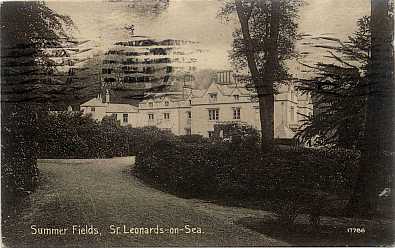 |
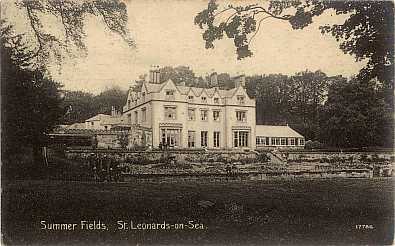 |
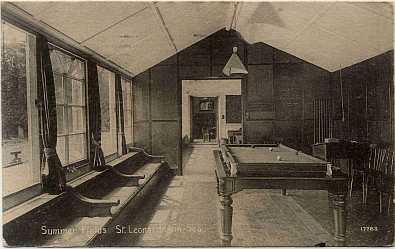 |
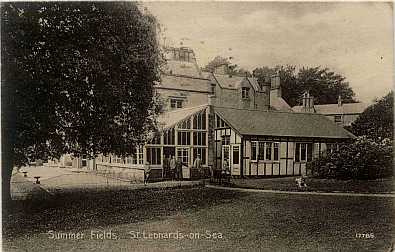 |
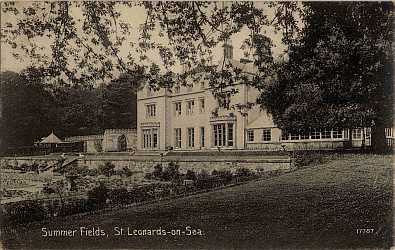 |
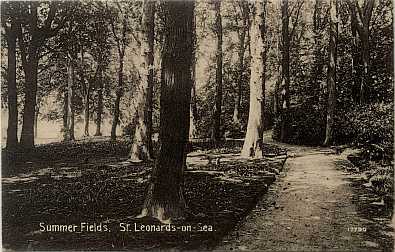 |
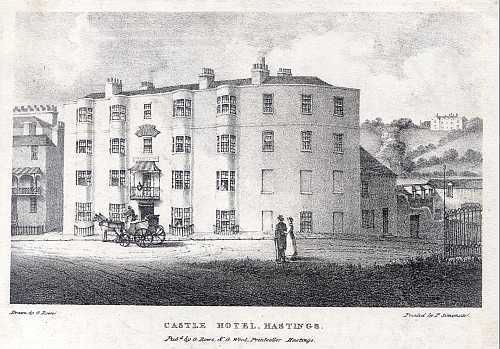 |
|
Above: Rowe's Castle Hotel Hastings after Wooll, Bohemia Mansion is shown in the distance on the right. Probably 1820's
Right: A view from "Lacey's Picturesque Views in Great Britain - Hastings & St. Leonards" - 1850's |
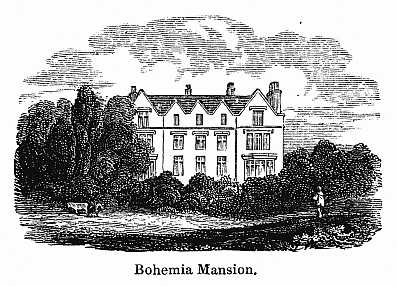 |
TIMELINE 1817 Bohemia Farm was demolished and Bohemia House built 1824 Bohemia House Constructed 1830 Princess of Gloucester stayed for three months. A notable event which warranted celebrations. 1831 Estate purchased by Wastel Brisco £8500 and remained with the Brisco’s until 1901( Musgrave Brisco was elected MP for Hastings 30 March 1844) 1903 Boys Prep School started by Dr G E Williams of Oxford and called the building and school Summer Fields. He extended the property to the southeast 1920 Summerfields House and other lands sold at auction at Castle Hotel Hastings by Major Arbuthnot Brisco comprising The House & Gardens and 10 other lots of nearby property. At the same time the 165 acre Filsham Farm and the 40 acre 9 hole Golf Course was auctioned. Sold. 1940 During the war the house was used as the Town Hall. 1945 After the war the house returned to use as a school 1966 Closed as a school. Furniture and school effects auctioned off. Purchased by HBC for £170,000 1970 Aug " Work has began on the new police station being built at Summerfields. It is hoped the building will be finished by 1972 HSLO Aug 8 P3 1971 February " The new fire brigade HQ at Bohemia Road was opened on Thursday and cost £193,000 HSLO February 27 1971 P1 1972 1st August Contract to demolish Summerfields House accepted by A Best £1655. House demolished and well filled in. 1972 17 October - Cast Iron Railings to Staircase -- Request to remove by R A Brimmell Esq. on behalf of Old Hastings Preservation Society. Recommended by General Purpose Committee. 1997 In July - Horntye Cricket Ground Trustees awarded £3,298,148 from Lottery Sports Fund. |
|
EARLY HISTORY OF THE SUMMERFIELDS AREA In early days the area was known as Crotesley or as recorded in the Doomsday Book as Croteslei. The lands stretched from Hollington including Bohemia to the sea. The sea swallowed part of the estate in 1320. The Manor House became Bohemia Farm and later Summer Fields House. This would appear to be one of the many properties owned by John Collier 1685-1760 and its association with the Collier family is on record ( Historic Hastings Tapestry of Life Tapestry of Life. J Mainwaring Baines Page 403 Footnote 22 Bohemia Farmhouse leased from John Colliers widow by Benjamin Foster and on her death passed to general James Murray and then William Green another Collier son in law. Thanks to Mr Hilary Barber for Collier detail) Bohemia House was built as a farmhouse by well known architect John (Yorky) Smith for G N Collinwood the son in law of Admiral Collinwood in about 1818. The building was constructed in a Jacobean style in 1824, on the south east side of the house there were two bay windows opening out onto a lawn and looking out onto an ornamental garden with a Ha Ha ensuring a good view beyond over lightly wooded grassland towards the sea. One of the important features of the house was an imperial style staircase constructed in pine with iron balustrades. During the summer of 1830 it is known that Princess Sophia of Gloucester spent three months here. A notable event celebrated by the ringing of church bells, the erection of banners and the firing of a salute and public dinners. In 1831 a sale catalogue for the house gave the following description of the newly completed building "The manor stands in the bosom of the hills, the grounds falling from it in front of a woody ravine and though on a lofty site it is admirably sheltered by the higher enclosures of the estate which rise above it and by a grove of oak and other timber. It is constructed of white bricks with stone corners and window mouldings in a most solid and substantial manner, In the picturesque style of an old English manor house. Having two advancing wings and gabled parapets and slated roof. The chimney octagonal." It went on to speak about its advantages "For a nobleman or a man of fashion desiring a residence on the coast." Before completion of the house the building was sold to Wastel Brisco who purchased the house for 8500 Pounds. He was the younger brother of Musgrave Brisco the MP who was elected to Parliament 30 March 1844. Musgrave Brisco however was involved in local politics and was elected mayor of Hastings in 1842. He spent time improving the house and was responsible for the construction of the Mock Roman Bath in the grounds. Wastel was also responsible for the stone greyhounds within the garden of the house. To the north west of the house was the coach house for two carriages and stalls for six horses a harness room and sleeping accommodation for the grooms. A semi-circular trough at the end of the building was the midden. The manure would have been taken to the vegetable garden a short distance away opposite Little Horntye. Access to the house was by two entrance lodges in Bohemia Road. The North Lodge was located opposite 220 Bohemia Road (site of fire station). Access to the house was along a short drive giving access kitchens and stables. On the left before reaching the stables was an icehouse used for the storage of food. When it was used as a house there was access to a turning circle outside the front entrance to the house. In later years the South Lodge located opposite Magdalen Road was the main entrance and the drive went past lightly wooded land and a walled garden where the south facing brick wall was faced in sandstone in order to look attractive. |
|
SUMMERFIELDS PREPATORY SCHOOL 1903 In 1903 Dr G E Williams of Oxford started a boy’s prep school and there were 60 and 80 boys’ age 8-13 years using the building for 60 years. Well-known pupils included
During the last war the House was used as the Town Hall and it reverted to use as a school after the war. The school was closed in 1966. On Tuesday 2nd August 1966 John Bray and Sons Ltd of 11 Warrior Square held an auction of household and school furniture composed of 635 lots. |
|
SUMMERFIELDS IN THE CARE OF HASTINGS COUNCIL Apparently after a survey the Hastings Area Archaeological Research Group were responsible for the construction of a model of the house and grounds as they were in 1831. This model was preserved within the Hastings Museum (David Thornton Page 293) The house was purchased by Hastings Borough Council for £170,000 and appears to have remained unused for a number of years. Eventually the Council made a decision and in the words of David Thornton " To the shame of Hastings was pulled down in 1972" (Tapestry of Hastings Life by David Thornton Page 285) Close to the cricket ground are the remains of two courts for the game of fives similar to squash. The fives courts were constructed in tribute of those who died in the 1914-18 war and a recovered plaque which was located in the viewing area between the two courts is in store for inclusion on the clubhouse when it is constructed. The courts are in good condition and with a little renovation could be brought into use. Slightly north of the created badger sett and just in from the area which is kept regularly cut as a badger deterrent there are further remains of the part of a buildings foundations. |
|
010706 040924 050122 050904 070618 080719 091229 100116 100116 100219 111228 121205 150701